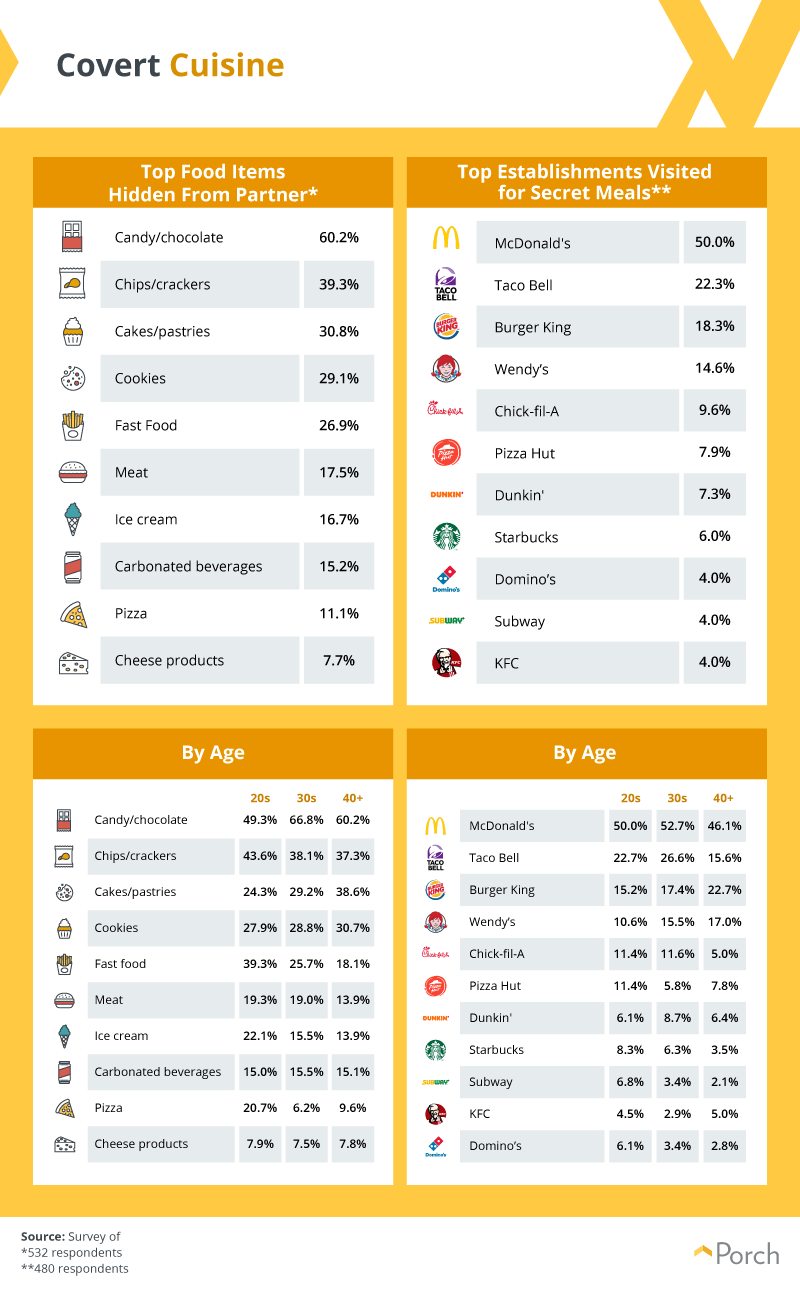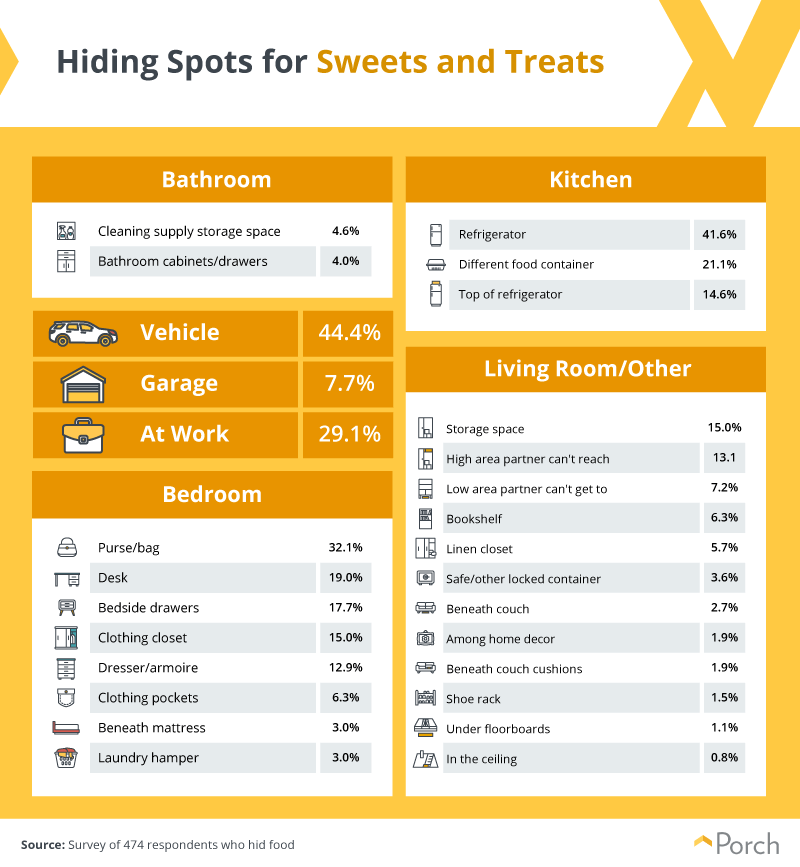Living with a romantic partner has many advantages: You have someone to share meals with, it’s cost-effective, and domestic responsibilities are (hopefully) divided. But once you commit, most things aren’t, well, private anymore.
When you cohabitate, it becomes more difficult to keep secrets, even if those secrets are just french fries from McDonald’s. To understand why people keep food hidden in their relationships, we surveyed 625 people living with their partners. Read on as we examine their reasons and learn where they hide the edible contraband.
Because it’s mine

One thing is for sure: When you move in with another person, you no longer have your own space. What’s yours will likely become theirs, and they’ll probably ask you to share your oatmeal raisin cookies (even if they said they hated oatmeal when you were dating).
More than half of the people in our study who said they hid food from their live-in partner, did so because they didn’t want to share. Nearly 59 percent of women expressed this sentiment, compared to 43.6 percent of men.
Food-shaming isn’t always obvious. For example, we label some foods as “guilt-free,” which implies that others are shameful. Perhaps that’s why almost 46 percent of people hid food from their significant others because they were ashamed of their choices. While women were most affected by shame, there was only a 4 percentage point difference—43 percent of men were ashamed of their diet, compared to 47 percent of women. Roughly 34 percent of women and 39 percent of men also said they kept a healthy diet as a front but concealed unhealthy options.
If keeping a secret stash of junk food isn’t enough to worry about, 7.3 percent of people reported that their stashing habits attracted pests. Men kept food hidden 38 times per year, on average, and women nearly 37 times—crumbs are bound to attract guests.
Honey, I’ve got secrets

Of course, those secrets were sweet: The No. 1 items people hid from their live-in partners were candy or chocolate products, followed by chips or crackers (39.3 percent). Nearly 31 percent hid baked goods, like cake—whoever got away with hiding an entire cake deserves to have their cake and eat it, too.
McDonald’s sold its 100-millionth hamburger in 1958, and things aren’t slowing down for the franchise (it’s estimated that current burger sales total more than 300 billion). When people wanted to keep a meal hidden from their partners, half of them snuck away to McDonald’s, with more people in their 30s (52.7 percent) reporting doing this than any other age group.
Thirty-somethings also snuck out to Taco Bell and Chick-fil-A more than 20-somethings and those aged 40 and older, but the older age group was more likely to sneak away to Wendy’s and Burger King without telling their partners.
Don’t check there

According to research, the worst part about keeping a secret is our minds—we continually return to the reality that we’re keeping something hidden. Now, imagine living with your secrets every day. Most participants in our study did.
Their hidden food was a reminder at work (29 percent), in the car (44 percent), and even in the laundry basket (3 percent). Nearly 42 percent even hid their food stash in the fridge, maybe behind that old bag of onions. More than 1 in 5 also hid their forbidden treats in another food container—what a ruse.
People went as far as hiding food in some unconventional places, too. About 2 percent kept food under the couch cushions and within home decor—behind a painting, for example. Less than 1 percent of participants kept the food they didn’t want their partners to find hidden in the ceiling or under the floorboards.
How harmful are food secrets?

As previously mentioned, how we feel about our secrets is what gets us into a pickle, usually. The majority, 34.6 percent, expressed feeling only a little bit of guilt about hiding food from a live-in partner. While nearly 25 percent percent didn’t feel any guilt at all.
Here’s a revelation: People’s guilt toward keeping food secrets correlated with their partner’s awareness of the habit. Thirty percent of people whose significant others hid food from them said it had a positive impact on their relationship. Maybe they were on a strict diet, so their live-in partner hid the sweets in good faith? Conversely, of the people who did the hiding, more than 8 in 10 said it had neither a positive nor negative impact on the relationship—things went on as usual.
What’s left to hide?
Although the share of Americans who have lived with a romantic partner is now higher than the marriage rate, our findings show that cohabitation doesn’t bring all secrets to light. People with live-in partners kept food secrets hidden all over the house, including under the couch and in the ceiling.
If you or your partner’s food-hiding habits have left your home in need of an upgrade (such as new floorboards), visit Porch. Whether the project is a small to-do or a more extensive task, we’ll work with you to find the right person to help you complete any home improvement project.
Methodology and limitations
We surveyed 625 people living with their significant others using Amazon’s Mechanical Turk service in January of 2020. The median age of respondents was 34, and there was a standard deviation of 10.75. There were 420 women who took the survey and 205 men. These data have not been statistically tested. It is also important to understand that all of these data are self-reported; there are limitations to self-reported data, such as over or underestimations of things.
Fair use statement
There’s nothing to hide here: Please share our study about hiding food in relationships with those you know. Maybe it’ll spark a conversation and encourage people to honor their eating habits. The graphics and information are reserved for noncommercial reuse. Please link back to this page and give the authors credit.

